Shoulder Dislocation
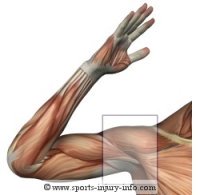
Most commonly seen with contact sports, dislocations are most common in football, but can also occur in other sports.
Understanding how dislocations occur, first step treatments, and surgical options can get you back in the game quickly and safely.
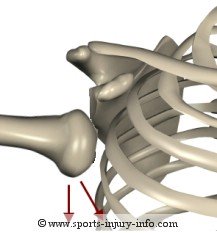 What
is a Shoulder Dislocation?
What
is a Shoulder Dislocation?
Simply put, a it is when the head
of the humerus
comes out of the shoulder "socket" due to trauma of some kind. 
The vast majority of dislocations occur anteriorly: this means the humerus slides out of socket toward the front of the shoulder. For a closer look at what a dislocation is, lets explore the shoulder anatomy.
The shoulder, or glenohumeral joint, is comprised of the humerus and the glenoid fossa of the scapula. While many call the shoulder a ball and socket joint, it is not nearly as stable as the hip, which is closer to a ball and socket.
The best analogy for the shoulder joint would be to imagine placing a basketball on a tea saucer. The shoulder joint sacrifices stability for mobility.
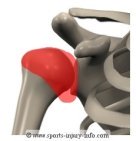
With sudden and overpowering stresses, the humerus can be dislodged from the glenoid, resulting in a dislocation.
Another common injury similiar to a shoulder dislocation is a shoulder subluxation. In essence, this is a partial dislocation, where the humerus slides part of the way out of socket. Shoulder subluxations often reduce spontaneously, meaning the humerus returns to the socket on its own.
Learn More About Shoulder Anatomy
Mechanism of Injury
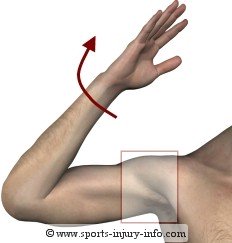
Most dislocations occur with the arm in a position away from the body, often overhead, and then with the arm rotated backwards.
This injury can also occur from falling on an outstretched arm, however this is not as common.
Signs Symptoms
The most obvious symptom of a shoulder dislocation is the humerus being out of socket. There is generally an obvious deformity, and the shoulder looks "funny".Since most dislocations occur anteriorly, there may be a large bump in the front of the shoulder where the humerus is. Pain is usually significant with a dislocation, and you will generally not be able to move the arm. Numbness or tingling of the arm and fingers may accompany a dislocation as well.
Tissues Injured
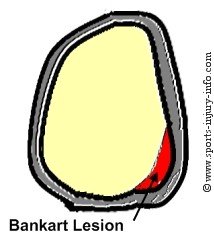
In addition, the labrum, or cartilage of the shoulder, is also injured, often pulling away from the bone. Commonly called a Bankart lesion, this type of labral tear is found in 98% of all anterior shoulder dislocations.
Most of the pain with shoulder dislocations is found in the front of the shoulder, and is due to the damage to the soft tisses in this area.
You may also suffer from a depression fracture on the posterior or back side of the humerus. This is called a Hill-Sachs lesion, and usually will not need to be treated specifically.
Treatment
Acute treatment for shoulder dislocations involves reduction of the dislocation, or putting the humerus back into place. This should be done only by a trained physician in an emergency room or hospital setting.Reduction may be performed with or without anesthesia, depending on how much the muscles have spasmed. The longer the shoulder is out of socket, the harder it becomes to reduce the dislocation. X-rays are generally taken before and after reduction to monitor the position of the humerus.
Following reduction, a sling is applied, and should be worn continuously for the next 2-3 weeks at a minimum. Immobilization of the shoulder through a sling allows for the anterior capsule to heal, and to prevent excessive stretching of the tissues. After 2-3 weeks of sling use, shoulder rehabilitaiton can begin, focusing on gently regaining range of motion, and then progressing to strengthening excercises.
Return to play following this injury can generally occur 3-4 months after injury, depending on the type of sport. Regaining full range of motion and strength is vitally important, as well as improving the overall stability of the joint.
Recurrance Rate
After a dislocation, the chances of a subsequent dislocation are greatly increased. Over half of all athletes who suffer from this injury will have another dislocation if not treated surgically.This is due to the stretching of the shoulder capsule, and the likeliness of the Bankart lesion. With this in mind, acute dislocations are sometimes treated surgically within the first 1-2 weeks. Whether or not to have surgery can be a complicated decision, and this should be discussed with your orthopedic surgeon.
Summary
Shoulder dislocations are a serious sports injury and must be treated appropriately in order to recover fully. Rest, immobilization, and rehabilitation are essential for the best outome. Even with proper treatment, some shoulder dislocations result in instability and may require surgery.Didn't find what you were looking for? Search SII for more information...
Running Pain Solutions
Written for Runners by a runner, you'll learn a holistic approach to improving mobility, restoring normal movement and muscle activation patterns, and restoring the body and mind connection.
This Kindle Book contains a step by step program to keep you running pain free. Included are detailed instructions and illustrations for exercises to improve mobility, balance, neuromuscular control, strength and endurance. Only $7.49!
Get Your Copy Today!









